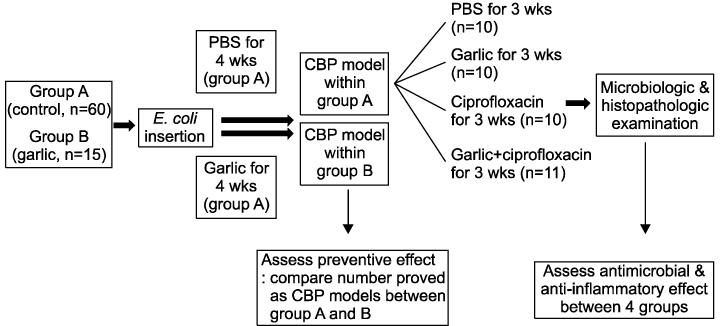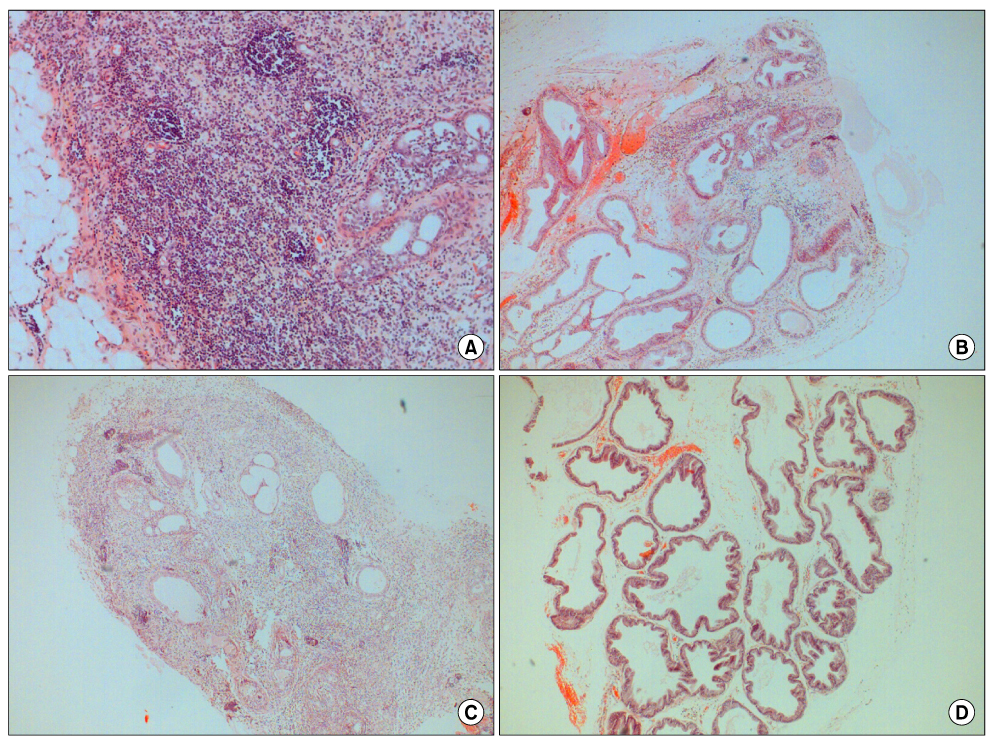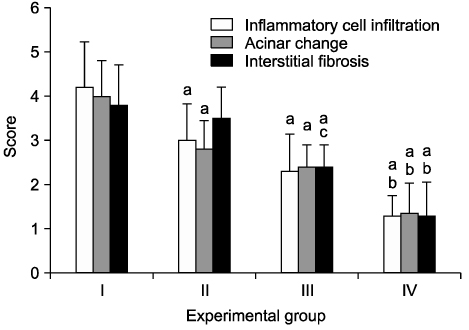Korean J Urol.
2009 Jun;50(6):602-608. 10.4111/kju.2009.50.6.602.
Preventive Effect on Inflammation and Anti-Inflammatory and Anti-Microbial Effects of Garlic Extract in a Rat Model of Chronic Bacterial Prostatitis
- Affiliations
-
- 1Department of Urology, The Catholic University of Korea College of Medicine, Seoul, Korea. cyh0831@catholic.ac.kr
- KMID: 1989794
- DOI: http://doi.org/10.4111/kju.2009.50.6.602
Abstract
-
PURPOSE: Garlic has anti-microbial and anti-inflammatory effects. We investigated its actions and preventive effects on chronic bacterial prostatitis (CBP) using a rat model.
MATERIALS AND METHODS
Bacterial suspension was inserted into the prostatic urethra of 75 rats. Then 15 were grouped as garlic group, and 60 as control group. Garlic and saline were given to each group for 4 weeks, respectively. After partial resection of the prostate, microbiological culture and histological examination were done. The incidence of CBP was compared between two groups. To evaluate the anti-microbial and anti-inflammatory effect of garlic, the 41 rats proved as CBP models among the control group were divided into 4 groups randomly: I, control; II, garlic; III, ciprofloxacin; IV, garlic plus ciprofloxacin. After 3 weeks of treatment, microbiological cultures of urine, prostate and histological examination of prostate were done.
RESULTS
In study of the preventive effects, 5 rats in garlic treatment group and 41 rats in control group were shown to be CBP models. In anti-microbial and anti-inflammatory evaluation, positive urine culture rate and prostate tissue show no significant difference among four groups, but bacterial growth in urine and prostate tissue were lower in groups II, III, and IV than group I. Bacterial growth was the slowest in prostate tissue of group IV. Histologic findings were more improved in groups II, III and IV than group I, with Group IV being the most improved.
CONCLUSIONS
These results show that garlic has preventive and therapeutic effects on CBP. Combination treatment with antibiotics may be considered in the future.
Keyword
MeSH Terms
Figure
Cited by 1 articles
-
Chronic Bacterial Prostatitis
Heung Jae Park
Korean J Urogenit Tract Infect Inflamm. 2014;9(1):21-26. doi: 10.14777/kjutii.2014.9.1.21.
Reference
-
1. Cho YH, Lee SJ, Lee JY, Kim SW, Lee CB, Lee WY, et al. Antibacterial effect of intraprostatic zinc injection in a rat model of chronic bacterial prostatitis. Int J Antimicrob Agents. 2002. 19:576–582.2. Woo YN. Prostatitis. Korean J Urol. 1994. 35:575–585.3. Clemens JQ, Meenan RT, O'Keeffe-Rosetti MC, Gao SY, Calhoun EA. Incidence and clinical characteristics of National nstitutes Health type III prostatitis in the community. J Urol. 2005. 174:2319–2322.4. Nickel JC, Patel M, Cameron M. Chronic prostatitis/chronic elvic pain syndrome: finding a way forward in the United ingdom: report from the first United kingdom symposium on hronic prostatitis, January 30, 2008, london, United Kingdom. Rev Urol. 2008. 10:160–163.5. Duclos AJ, Lee CT, Shoskes DA. Current treatment options n the management of chronic prostatitis. Ther Clin Risk Manag. 2007. 3:507–512.6. Lee YS, Han CH, Kang SH, Lee SJ, Kim SW, Shin OR, et al. Synergistic effect between catechin and ciprofloxacin on hronic bacterial prostatitis rat model. Int J Urol. 2005. 12:383–389.7. Choi YS, Cho YH, Han CH. Synergistic effect between Ginsenoside or Urovaxom® with ciprofloxacin on chronic bacterial prostatitis rat model. Korean J Urol. 2007. 48:849–857.8. Shoskes DA, Manickam K. Herbal and complementary medicine in chronic prostatitis. World J Urol. 2003. 21:109–113.9. Pinto JT, Rivlin RS. Antiproliferative effects of allium derivatives from garlic. J Nutr. 2001. 131:Suppl. 1058–1060.10. Bhang WJ, Cheon J, Kim SC. Allium sativum-mediated therapy for experimental prostate cancers with in vivo tumor transduction: effects on tumor growth and development. Korean J Urol. 2001. 42:663–667.11. Devrim E, Durak I. Is garlic promising food for benign prostatic hyperplasia and prostate cancer? Mol Nutr Food Res. 2007. 51:1319–1323.12. Lee YS, Shin MS, Cho YH. Experimental animal model of bacterial prostatitis. Korean J Urol. 2001. 42:636–641.13. Seo SI, Lee SJ, Kim JC, Choi YJ, Kim SW, Hwang TK, et al. Effects of androgen deprivation on chronic bacterial prostatitis in a rat model. Int J Urol. 2003. 10:485–491.14. Wagenlehner FM, Diemer T, Naber KG, Weidner W. Chronic bacterial prostatitis (NIH type II): diagnosis, therapy and nfluence on the fertility status. Andrologia. 2008. 40:100–104.15. Naber KG, Roscher K, Botto H, Schaefer V. Oral levofloxacin 500 mg once daily in the treatment of chronic bacterial prostatitis. Int J Antimicrob Agents. 2008. 32:145–153.16. Kunishima Y, Takeyama K, Takahashi S, Matsukawa M, Koroku M, Tanda H, et al. Gatifloxacin treatment for chronic prostatitis: a prospective multicenter clinical trial. J Infect Chemother. 2008. 14:137–140.17. Ruddock PS, Liao M, Foster BC, Lawson L, Arnason JT, Dillon JA. Garlic natural health products exhibit variable constituent levels and antimicrobial activity against Neisseria gonorrhoeae, Staphylococcus aureus and Enterococcus faecalis. Phytother Res. 2005. 19:327–334.18. Davis SR. An overview of the antifungal properties of allicin and its breakdown products-the possibility of a safe and effective antifungal prophylactic. Mycoses. 2005. 48:95–100.19. Amagase H, Petesch BL, Matsuura H, Kasuga S, Itakura Y. Intake of garlic and its bioactive components. J Nutr. 2001. 31:Suppl. 55–62.20. Hodge G, Hodge S, Han P. Allium sativum (garlic) suppresses leukocyte inflammatory cytokine production in vitro: potential therapeutic use in the treatment of inflammatory bowel disease. Cytometry. 2002. 48:209–215.21. Pittler MH, Ernst E. Clinical effectiveness of garlic (Allium sativum). Mol Nutr Food Res. 2007. 51:1382–1385.22. Eja ME, Asikong BE, Abriba C, Arikpo GE, Anwan EE, Enyi-Idoh KH. A comparative assessment of the antimicrobial effects of garlic (Allium sativum) and antibiotics on diarrheagenic organisms. Southeast Asian J Trop Med Public Health. 2007. 38:343–348.23. Gupta S, Ravishankar S. A comparison of the antimicrobial activity of garlic, ginger, carrot, and turmeric pastes against Escherichia coli O157:H7 in laboratory buffer and ground beef. Foodborne Pathog Dis. 2005. 2:330–340.24. Hunter R, Caira M, Stellenboom N. Thiosulfinate allicin from garlic: inspiration for a new antimicrobial agent. Ann N Y Acad Sci. 2005. 1056:234–241.25. Galeone C, Pelucchi C, Talamini R, Negri E, Dal Maso L, Montella M, et al. Onion and garlic intake and the odds of benign prostatic hyperplasia. Urology. 2007. 70:672–676.26. Lang A, Lahav M, Sakhnini E, Barshack I, Fidder HH, Avidan B, et al. Allicin inhibits spontaneous and TNF-alpha induced secretion of proinflammatory cytokines and chemokines from intestinal epithelial cells. Clin Nutr. 2004. 23:199–208.
- Full Text Links
- Actions
-
Cited
- CITED
-
- Close
- Share
- Similar articles
-
- Anti-Inflammatory Effect of Phlorotannin on Chronic Nonbacterial Prostatitis in a Rat Model
- Anti-inflammatory Effect of Lycopene on Chronic Bacterial Prostatitis Rat Model
- Anti-Inflammatory and Antimicrobial Effects of a Novel Herbal Formulation (WSY-1075) in a Chronic Bacterial Prostatitis Rat Model
- Synergistic Effect between Ginsenoside or Urovaxom(R) with Ciprofloxacin on Chronic Bacterial Prostatitis Rat Model
- The Comparison of the Effects of Oral Antibiotic Ingestion and Intraprostatic Antibiotic Injection in a Rat Model of Chronic Bacterial Prostatitis




